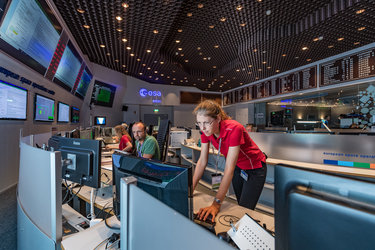Accept all cookies Accept only essential cookies See our Cookie Notice

About ESA
The European Space Agency (ESA) is Europe’s gateway to space. Its mission is to shape the development of Europe’s space capability and ensure that investment in space continues to deliver benefits to the citizens of Europe and the world.
Highlights
ESA - United space in Europe
This is ESA ESA facts Member States & Cooperating States Funding Director General Top management For Member State Delegations European vision European Space Policy ESA & EU Space Councils Responsibility & Sustainability Annual Report Calendar of meetings Corporate newsEstablishments & sites
ESA Headquarters ESA ESTEC ESA ESOC ESA ESRIN ESA EAC ESA ESAC Europe's Spaceport ESA ESEC ESA ECSAT Brussels Office Washington OfficeWorking with ESA
Business with ESA ESA Commercialisation Gateway Law at ESA Careers Cyber resilience at ESA IT at ESA Newsroom Partnerships Merchandising Licence Education Open Space Innovation Platform Integrity and Reporting Administrative Tribunal Health and SafetyMore about ESA
History ESA Historical Archives Exhibitions Publications Art & Culture ESA Merchandise Kids Diversity ESA Brand Centre ESA ChampionsLatest
Space in Member States
Find out more about space activities in our 23 Member States, and understand how ESA works together with their national agencies, institutions and organisations.
Science & Exploration
Exploring our Solar System and unlocking the secrets of the Universe
Go to topicAstronauts
Missions
Juice Euclid Webb Solar Orbiter BepiColombo Gaia ExoMars Cheops Exoplanet missions More missionsActivities
International Space Station Orion service module Gateway Concordia Caves & Pangaea BenefitsLatest
Space Safety
Protecting life and infrastructure on Earth and in orbit
Go to topicAsteroids
Asteroids and Planetary Defence Asteroid danger explained Flyeye telescope: asteroid detection Hera mission: asteroid deflection Near-Earth Object Coordination CentreSpace junk
About space debris Space debris by the numbers Space Environment Report In space refuelling, refurbishing and removingSafety from space
Clean Space ecodesign Zero Debris Technologies Space for Earth Supporting Sustainable DevelopmentLatest
Applications
Using space to benefit citizens and meet future challenges on Earth
Go to topicObserving the Earth
Observing the Earth Future EO Copernicus Meteorology Space for our climate Satellite missionsCommercialisation
ESA Commercialisation Gateway Open Space Innovation Platform Business Incubation ESA Space SolutionsLatest
Enabling & Support
Making space accessible and developing the technologies for the future
Go to topicBuilding missions
Space Engineering and Technology Test centre Laboratories Concurrent Design Facility Preparing for the future Shaping the Future Discovery and Preparation Advanced Concepts TeamSpace transportation
Space Transportation Ariane Vega Space Rider Future space transportation Boost! Europe's Spaceport Launches from Europe's Spaceport from 2012Latest

ESOC takes control of Aeolus
Thank you for liking
You have already liked this page, you can only like it once!
ESA’s Aeolus satellite was launched yesterday, soon to become the first-ever satellite to directly measure Earth’s winds from space.
During a gripping night at ESA’s operations centre in Germany, mission teams looked on nervously as Aeolus was thrust heavenwards atop a Vega rocket from Europe’s Spaceport in Kourou, French Guiana.
This image, taken in the Main Control Room of the European Space Operations Centre (ESOC) in Darmstadt, captures the moment that mission teams took over control of the satellite from the launchsite in Kourou, about an hour after liftoff.
Carrying one of the most sensitive instruments ever put into orbit — Aladin, a Doppler wind lidar — Aeolus will provide vital information on wind speeds around the globe. This information is expected to vastly improve weather forecasting as wind plays a complex, pivotal role in global weather systems.
Ironically, liftoff was delayed by 24 hours, after high winds meant it was unsafe to launch the satellite as initially planned on 21 August. Because of unclear weather predictions, the launch service provider — Arianespace — was only able to give about 24 hours notice of the delay, highlighting the need for more accurate wind models.
The next stage for Aeolus is its Launch and Early Orbit Phase (LEOP), during which flight controllers, satellite engineers and experts in flight dynamics are working non-stop to gradually switch on the satellite’s various control systems and verify its health.
-
CREDIT
ESA/J. Mai -
LICENCE
ESA Standard Licence

Critical days for Aeolus

In the Main Control Room during Aeolus launch

Final Aeolus simulation in ESOC Main Control Room

Aeolus















 Germany
Germany
 Austria
Austria
 Belgium
Belgium
 Denmark
Denmark
 Spain
Spain
 Estonia
Estonia
 Finland
Finland
 France
France
 Greece
Greece
 Hungary
Hungary
 Ireland
Ireland
 Italy
Italy
 Luxembourg
Luxembourg
 Norway
Norway
 The Netherlands
The Netherlands
 Poland
Poland
 Portugal
Portugal
 Czechia
Czechia
 Romania
Romania
 United Kingdom
United Kingdom
 Slovenia
Slovenia
 Sweden
Sweden
 Switzerland
Switzerland

























